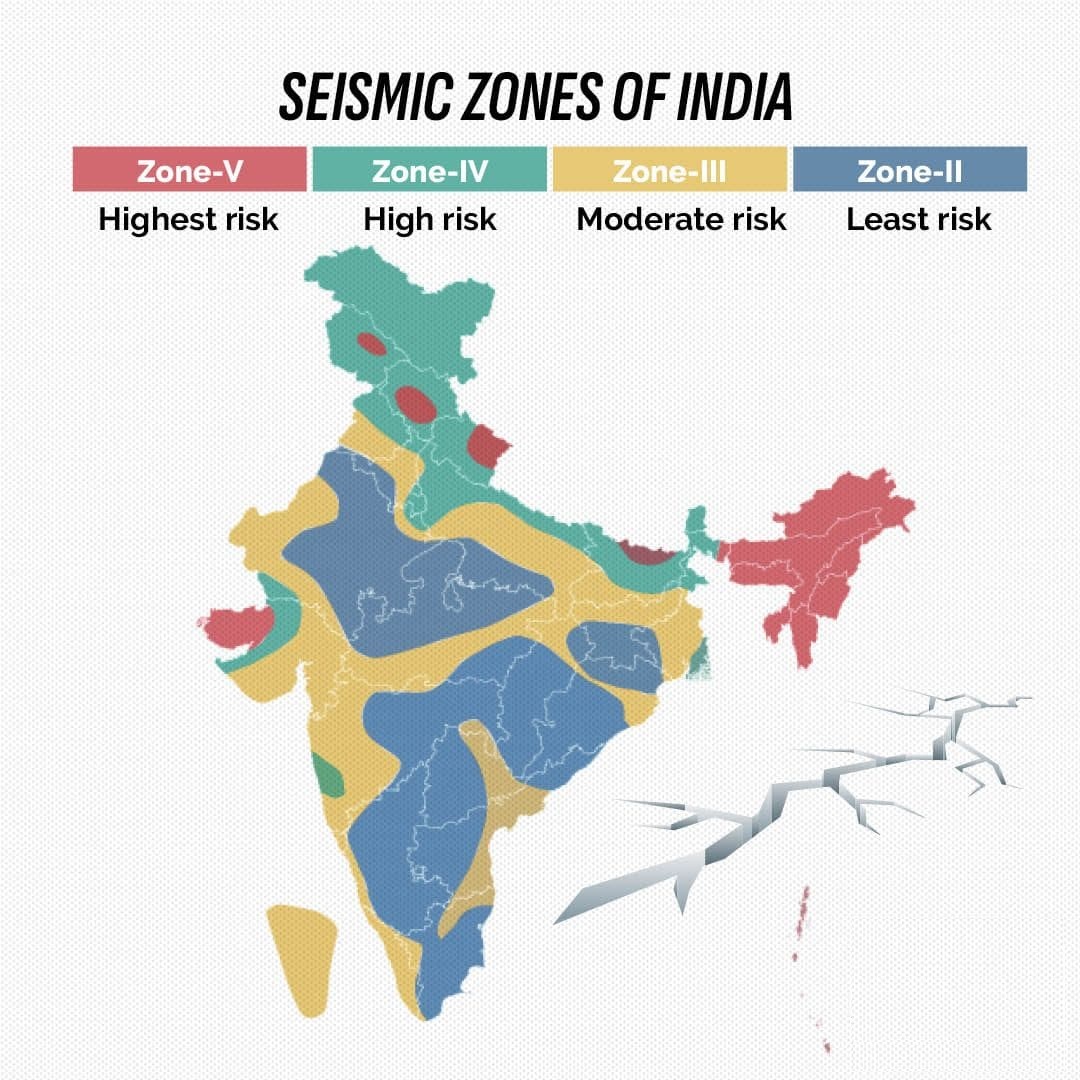PYQ Relevance:[UPSC 2015] Earthquakes along the plate margins are still a cause of concern. India’s preparedness for mitigating their impact has significant gaps. Discuss various aspects. Linkage: The article emphasizes that India’s seismic risk is rooted in the northward drift of the Indian Plate colliding with the Eurasian Plate, which shaped the Himalayas and makes the region “overdue for a ‘Great Himalayan Earthquake’. The question specifically mentions “earthquakes along the plate margins” and critically highlights “India’s preparedness for mitigating their impact has significant gaps. |
Mentor’s Comment: The 4.4 magnitude tremor in Delhi on July 10, 2025, though moderate, exposed the critical fragility of India’s infrastructure, especially in Delhi, where over 80% of buildings violate seismic safety norms. This event is part of a wider pattern of seismic activity across Asia, underlining the urgent need for earthquake preparedness. India, particularly northern and northeastern regions, lies in high-risk seismic zones (IV & V) due to the collision of tectonic plates, making a massive quake imminent. Urbanisation, outdated construction, and poor enforcement of seismic codes like IS 1893:2016 worsen the risk.
Today’s editorial analyses the vulnerability to earthquakes in India. This topic is important for GS Paper I (Geography) and GS Paper III (Disaster Management) in the UPSC mains exam.
_
Let’s learn!
Why in the News?
On July 10, 2025, a 4.4 magnitude earthquake struck near Delhi, exposing the fragile state of infrastructure.
Why is Delhi vulnerable to earthquakes?
- High Seismic Risk Zone: Delhi lies in Seismic Zone IV, indicating a severe seismic hazard with a peak ground acceleration (PGA) of around 0.24g. Eg: Similar Zone IV cities like Srinagar and Patna have experienced strong tremors in the past.
- Poor Structural Compliance: Over 80% of buildings in Delhi, especially those constructed before 2000, do not comply with seismic safety codes. Eg: Unregulated high-rise apartments in East Delhi lack ductile detailing or shear walls, making them prone to collapse.
- Liquefaction-Prone Areas: Areas like East Delhi and Yamuna floodplains are built on soft alluvial soils, which are susceptible to liquefaction during earthquakes. Eg: In the 2001 Bhuj earthquake, structures on soft soil experienced severe tilting and collapse.
- Rapid Urbanisation Without Planning: Delhi’s urban sprawl and dense population (over 33 million) have led to haphazard construction, often violating zoning and structural norms. Eg: Many illegal colonies like those in outer Delhi lack any seismic design considerations.
What are the vulnerable areas in India?
|
What are the steps taken by the Indian Government?
- Building Code Reforms: The government enforces Earthquake-Resistant Building Codes to ensure structural safety in seismic zones. Eg: The Bureau of Indian Standards (BIS) revised IS 1893 and IS 4326 to include updated seismic design norms across construction sectors.
- National Seismic Zoning: India has been zoned into seismic risk areas to guide planning and construction based on earthquake vulnerability. Eg: The country is divided into Zone II to Zone V, with Zone V (like parts of Uttarakhand, Kashmir) being most earthquake-prone.
- Disaster Management Framework: The government has established a dedicated institutional framework to coordinate disaster preparedness and response. Eg: The National Disaster Management Authority (NDMA) issues guidelines for earthquake risk mitigation and conducts regular mock drills and capacity-building programs.
What are the steps taken at the international level?
- Sendai Framework for Disaster Risk Reduction (2015–2030): The United Nations adopted this global framework to strengthen disaster preparedness, promote resilient infrastructure, and reduce disaster losses. Eg: Countries like Japan and Chile have aligned their national disaster policies with Sendai priorities, emphasizing risk governance and early warning.
- Global Seismic Hazard Assessment Program (GSHAP): Led by the International Lithosphere Program, this initiative provides seismic hazard maps to help countries plan safer infrastructure. Eg: Italy and other European nations use GSHAP data to revise building codes and zoning laws in earthquake-prone zones.
- Early Warning Systems and Technology Sharing: Countries are collaborating to develop earthquake early warning systems and share real-time seismic data across borders. Eg: The Pacific Tsunami Warning Center and Japan’s Earthquake Early Warning System help neighbouring nations prepare faster for seismic events.
What global lessons can India adopt from other countries? (Way forward)
- Building Code Enforcement: Strong and regularly updated building codes ensure that infrastructure can withstand seismic shocks, reducing casualties and damage. Eg: After the 1995 Kobe earthquake, Japan revised its seismic building codes, which helped limit destruction during the 2011 Tōhoku earthquake.
- Early Warning Systems: Timely alerts enable people to take quick protective actions, such as evacuation or shutting down utilities, before the shaking begins. Eg: In 2017, Mexico City’s SASMEX system gave a 20-second alert before the quake struck, allowing residents to prepare.
- Retrofitting Incentives: Providing financial support for retrofitting older buildings motivates citizens to strengthen structures against earthquakes. Eg: The Earthquake Brace + Bolt program in California offers funds to homeowners, promoting structural safety in vulnerable areas.
Get an IAS/IPS ranker as your 1: 1 personal mentor for UPSC 2024


